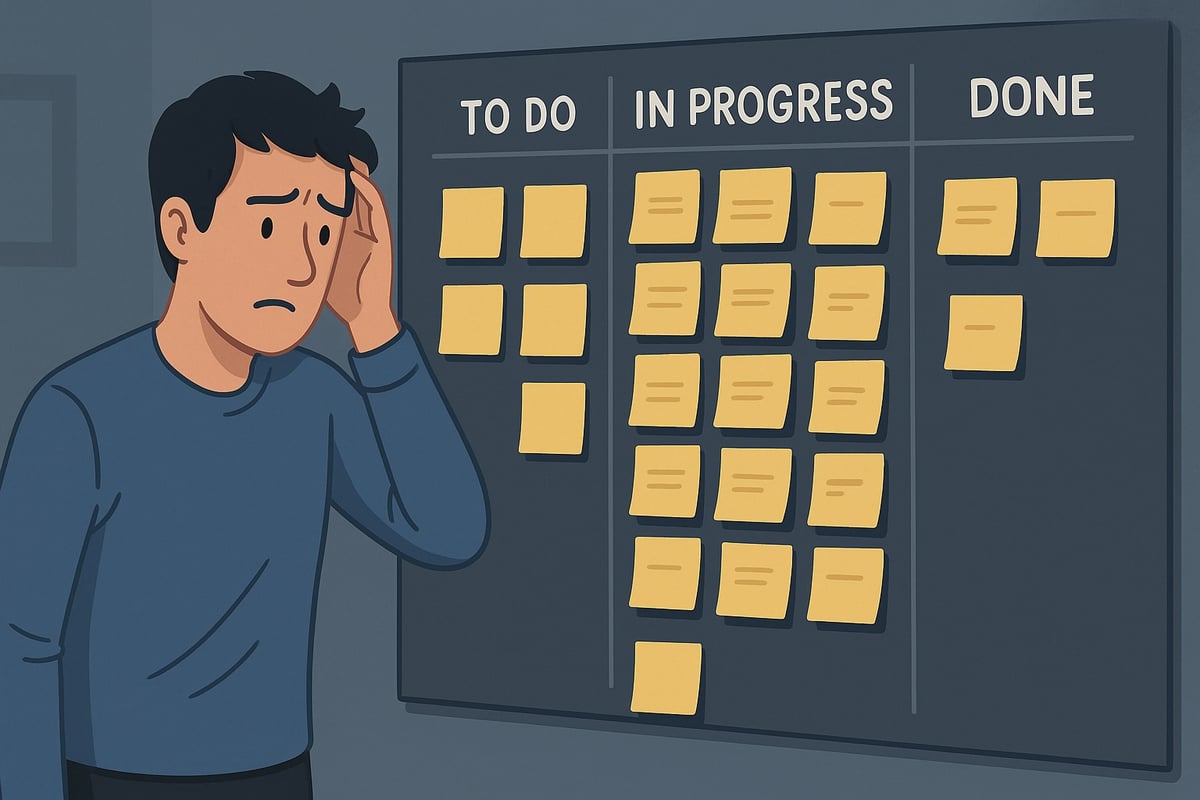Every engineering leader reaches a breaking point. Your calendar overflows with meetings, your inbox bursts with requests, and that architectural review sits untouched. Meanwhile, your team waits for decisions, creating bottlenecks that slow everyone down. The solution seems obvious: delegate more. But the challenge isn’t deciding to delegate—it’s delegating effectively without losing control of outcomes.
The Delegation Paradox: More Control Through Letting Go
The most counterintuitive aspect of delegation is that it actually increases your control in the long run. As HeyCona notes, “Delegation involves relinquishing control without relinquishing responsibility”.
When you delegate effectively, you’re not simply offloading tasks—you’re building a team capable of executing with minimal supervision. You gain a force multiplier that extends your impact far beyond what you could achieve alone.
Two critical mistakes derail most delegation efforts:
Micromanagement: Assigning tasks while maintaining tight control over execution. Research shows this significantly impacts team performance, with studies finding that 68% of employees who worked under micromanagers reported decreased morale and 55% reported reduced productivity (Harvard Business School). This approach stifles creativity and accelerates burnout.
Abdication: Dumping tasks without providing guidance, context, or support. This “sink or swim” approach leads to missed objectives, quality issues, and frustrated team members.
The sweet spot lies between these extremes: delegation that empowers while maintaining appropriate oversight.
The Delegation Formula: Trust + Autonomy + Accountability
Three elements consistently appear in successful delegation:
1. Trust: The Foundation
Without confidence in your team’s capabilities, you’ll inevitably micromanage or avoid delegating altogether.
To build trust:
- Start with small, lower-risk tasks to establish a success track record
- Recognize that trust is bidirectional—your team needs to trust your judgment and support
- Remember that trust compounds over time, allowing for increasingly significant delegation
2. Autonomy: The Enabler
As an engineering leader, you should:
- Delegate outcomes rather than tasks—”improve authentication response time by 40%” instead of “refactor the auth module”
- Give engineers space to find their own solutions
- Gradually increase autonomy as team members demonstrate capability
Jeff Bezos scaled Amazon using his “two-pizza team rule,” creating small, autonomous teams empowered to make decisions independently while working within strategic guardrails.
3. Accountability: The Guardrail
Accountability ensures that autonomy doesn’t become abdication. It involves:
- Clear expectations about deliverables, quality standards, and timelines
- Regular check-ins appropriate to task complexity and engineer experience
- Focusing on outcomes rather than process
Strategic Frameworks for Delegation
The 7 Levels Delegation Framework
Pluralsight recommends a framework with seven distinct levels:
- Tell: Leader decides; discussion not expected
- Sell: Leader decides then convinces team
- Consult: Leader asks for input first, then decides
- Agree: Leader and team decide together
- Advise: Team requests leader’s advice before deciding
- Inquire: Team decides and informs leader
- Delegate: Team decides independently
For example, architectural vision might fall under “Sell,” while implementing established patterns falls under “Delegate.” This framework helps you match the right delegation level to the decision at hand.
The Skill-Will Matrix
This framework, adapted from situational leadership theory, matches delegation approaches to team members’ readiness levels:
| Skill/Will Level | Delegation Approach | Example |
|---|---|---|
| High Skill/High Will | Full autonomy | “Own the API migration—check in when needed” |
| High Skill/Low Will | Coaching with rationale | “Lead the security audit; your expertise ensures compliance” |
| Low Skill/High Will | Training with check-ins | “Let’s pair initially, then you tackle the next set” |
| Low Skill/Low Will | Direct instruction | “Follow this guide; we’ll review after each section” |
Using this matrix helps you tailor your delegation approach to each team member’s unique capabilities and motivation levels.
What to Delegate vs. What to Retain
Technical Decisions to Delegate
Good candidates include:
- Implementation details: Coding approaches, testing strategies
- Technology selection within approved categories
- Process improvements: CI/CD optimizations, code reviews
- Technical documentation: API specs, diagrams
- Problem investigation: Root cause analysis, performance bottlenecks
- Feature development following established patterns
Decisions Leaders Should Retain
These typically include:
- Architectural vision: Long-term technical direction
- Resource allocation: Team composition, priorities
- Risk management: Security policies, compliance
- Cross-team coordination: Decisions affecting multiple teams
- Performance management: Evaluations, promotions
- Strategic alignment: Connecting tech work to business goals
Being deliberate about what you delegate versus what you retain creates clarity for your team and ensures you remain focused on high-leverage leadership activities.
Practical Tactics for Effective Delegation
Focus on Outcomes, Not Tasks
Specify what needs to be accomplished rather than how:
- Instead of “Refactor the authentication module,” try “Improve our auth system’s response time by 40% while maintaining security”
- Instead of “Create more unit tests,” try “Achieve 80% code coverage for core payment features”
This approach leverages engineers’ creativity while maintaining business alignment. It also shifts ownership of the solution to your team members, increasing their investment in the outcome.
Set Clear Expectations
Provide:
- Specific deliverables: What needs to be produced
- Quality standards: Performance requirements, metrics
- Timeline: Deadlines and milestones
- Resources: Available tools and support
- Decision authority: Autonomy limits and escalation triggers
Clarity at the outset prevents confusion and frustration later. When expectations are well-defined, team members can work confidently without constant supervision.
Establish Effective Check-ins
Base your check-in approach on:
- Task complexity and risk
- Engineer’s experience level
- Project timeline
The purpose of check-ins isn’t to control but to support and remove obstacles. Well-designed check-ins provide guidance without micromanaging.
Overcoming Common Challenges
The “I Could Do It Faster Myself” Mindset
Many leaders fall into the trap of thinking they can complete tasks more quickly than their team members. However, withholding opportunities prevents engineers from developing the skills they need to excel at these tasks in the future.
Overcome this by:
- Reframing delegation as an investment in team capability
- Recognizing that short-term efficiency creates long-term bottlenecks
- Focusing on long-term outcomes rather than immediate productivity
Remember that the time you invest in delegation today pays dividends through increased team capacity tomorrow.
Preventing Reverse Delegation
When engineers try to return delegated tasks:
- Clarify that problem-solving is included in the delegation
- Ask reflective questions instead of providing solutions
- Provide resources rather than answers
- Express confidence in their ability to handle the challenge
Standing firm against reverse delegation helps engineers grow and prevents you from becoming the bottleneck again.
Creating Psychological Safety
Build an environment where engineers feel comfortable taking risks by:
- Acknowledging your own mistakes
- Treating failures as learning opportunities
- Focusing on system improvement, not blame
Psychological safety is essential for delegation to work—team members need to know they won’t be punished for honest mistakes while learning.
Measuring Delegation Effectiveness
Look for these indicators:
- Team autonomy ratio: Decisions made without leader involvement
- Questions per task: Decreasing clarifications indicates improved clarity
- Initiative emergence: New ideas originating from the team
- Velocity trends: Consistent or increasing delivery
MentorCruise highlights two critical outcomes:
- “The successful delivery of the task/project”
- “The person gained meaningful experiences from it which are aligned with her growth goals”
Tracking these metrics helps you refine your delegation approach and demonstrate its impact on both team performance and individual growth.
For a deeper dive into how to measure engineering team performance and communicate these metrics effectively to stakeholders, see our guide on Metrics that Matter for Engineering Teams.
Conclusion: The Path to Delegation Mastery
Effective delegation is a skill developed through deliberate practice. The key principles:
- Balance is key: Finding the sweet spot between micromanagement and abdication
- Trust is fundamental: Without trust, delegation becomes controlling or disconnected
- Clarity creates confidence: Clear expectations enable autonomy
- Growth is the goal: Success is measured by increased team capability
- Leaders remain accountable: Delegating responsibility doesn’t mean abandoning accountability
Mastering delegation transforms engineering leadership from a bottleneck into a multiplier. When leaders empower their teams while maintaining appropriate guidance, both technical quality and team growth accelerate. Effective delegation also speeds up your delivery pipeline—reducing the cost of delay that can significantly impact your bottom line.
What’s your next move to improve delegation on your team?








